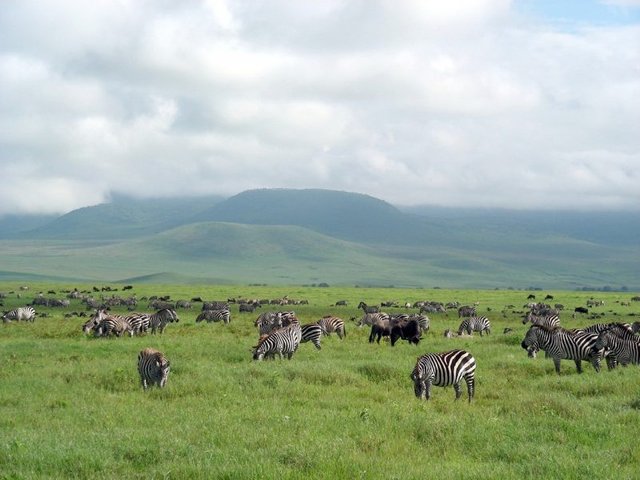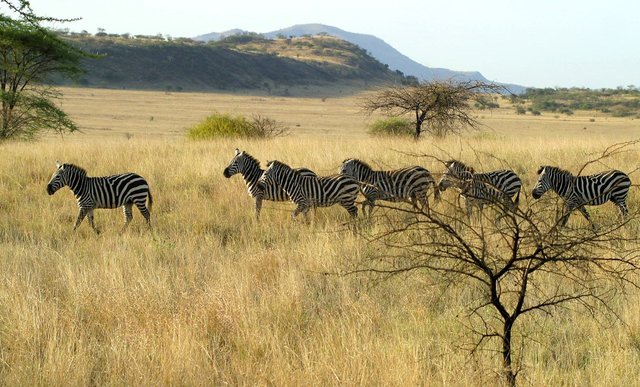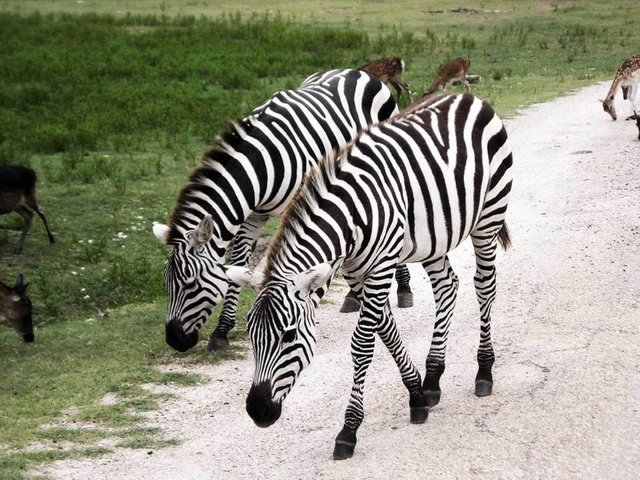
One of the peculiar features of zebras is their black and white stripped-patterned hide. It makes them the most beautiful animals in the jungle. Each of the three species of zebras, the Mountain zebra, the Grevy’s zebra and the Common zebra, has its general pattern. Mountain zebras have vertical stripes on its torso and neck but horizontal stripes on its haunches. The Grevy’s zebra has thin lines that curve upwards. Common zebra has horizontal stripes on its sides and broader stripes elsewhere.
Stripes are predetermined
The unique and peculiar patterns of zebra stripes is hereditary and determined by genetics. It has to do with selective pigmentation caused by melanocyte skin cells during the embryonic phase. Zebra embryos start out with dark skin. In the uterus, the dark pigment melanin deactivates its function for the hair follicles in certain areas of skin. Then they go on to develop white stripes before their birth. And that is how zebras get their black and white stripes.

Two old theories
Zebra stripes stand out among other African grazers. Their black and white stripes seem so out of place in the bush, in particular against a plain savanna background. So why have stripes at all when that would make them conspicuous and exposed to the ubiquitous predators? The zebra stripes remain a mystery to science even today. Zoologists have yet to unravel the mysteries behind its signature striped suit. Scientists are not sure why zebras have not blended in with the browns and reds or why they have stripes. There are many theories and counter-theories to this riddle of zebra stripes. Let us examine two popular theories people have had about the reasons as to why zebras have stripes.
Camouflage against predators
The most long-standing hypothesis of zebra stripes was the one debated by Alfred Russell Wallace and Charles Darwin. It goes as follows. The stripes of zebras blend well into the natural light and shade. Too many of such bars in one place form an optical illusion. And the streaks of a herd merge into a big mass. In other words, zebras running together as a pack appears like a giant striped blob. That makes it tough for predators to remain focused on a single zebra. So the predators get confused and misjudge distances at dawn and dusk. Hence stripes serve as camouflage devices to zebras.
Patterns of identification
Another longstanding theory was that zebras identify each other in a herd because of the uniqueness of the stripes. Stripes on their rear ends differ significantly. Hence the members can recognize their own at the front of the flock when running. Zebra’s distinctive black and white stripes are as unique as fingerprints in humans. No two are exactly alike. And in fact, researchers in the field have used their individual stripe patterns for identification.

Both theories refuted
In the jungle where zebras live, the stripes in a herd of zebras have a camouflaging effect. This keeps the predators away. But, ironically, to each zebra, the pattern is so unique that they use it to recognize each other. We use them as pedestrian crossings in the streets because the design stands out among the fast-moving motorists. However, a recent study has refuted both these theories. In a project supported by National Geographic Society, biologists visited 16 zebra populations in Africa. They tested these ideas to determine the veracity.
According to the study, scientists at UC Davis and the University of Calgary recently discredited the camouflage hypothesis. The studies and researches done by them provide no support that the stripes provide some camouflaging effect. In fact, they discovered that predators cannot distinguish zebra stripes beyond 30 meters at twilight or 50 meters in daylight. Moreover, they found that the predators could see the outline of zebras just as quickly as other prey. Neither did the new study yield enough evidence suggesting socializing advantage by allowing zebras to recognize each other. The researchers noted that other social animals that are closely related to zebras are also highly social. They are able to recognize their own despite having no stripes to distinguish them.

Two new theories
The researchers and scientists who refuted the earlier schools of thought as to why zebras have stripes attempt to list two likely answers to the question. The first is that the stripes have a cooling effect in warmer climates, and the second is that it helps to fend off parasites that are common in hotter climates. However, according to the journal, Royal Society Open Science, no one theory tease out as the definite winner.
Cooling eddy theory
One of the explanations shows that temperature is the factor linked to striping. In other words, stripes keep the zebras cool in warmer climates. Scientists found a correlation between temperature and the line patterns. The study proves that zebras in warmer climates have more stripes, to keep them cool, fresh or healthy. When the air currents hit a zebra, it is slower over the white parts and stronger and faster over the black parts. This causes opposing airflows. These little eddies of air swirl and serve to calm the zebra’s skin. There is evidence to suggest that heavily striped zebras have lower surface temperatures than non-striped animals in the same area. The alternating color pattern deflects up to 70% of the heat.
Parasite fender theory
New research shows that the stripes on zebras stave off disease-spreading insects and dissuade blood-sucking horseflies that recognize only single-colored fur. They are least attractive to a zebra’s hides because they don’t like to land on striped surfaces. Thus, the stripes act as an insect repellant. Gabor Horvath and colleagues from Sweden and Hungary discovered this. It was published in the Journal of Experimental Biology. The zebra’s stripy hide evolved to disrupt their beautiful coats making them less appealing to voracious bloodsuckers. Hence the striped coat pattern was a response to blood-sucking parasites.
Ongoing and future studies and field research may be able to solve the stripe-riddle of zebras. Or a whole new theory may emerge. Until they establish a black and white answer, the standard notions of zebra’s patterns will remain just that.
Congratulations @valjiwa! You have completed some achievement on Steemit and have been rewarded with new badge(s) :
Click on any badge to view your own Board of Honor on SteemitBoard.
For more information about SteemitBoard, click here
If you no longer want to receive notifications, reply to this comment with the word
STOPDownvoting a post can decrease pending rewards and make it less visible. Common reasons:
Submit
Congratulations @valjiwa! You received a personal award!
You can view your badges on your Steem Board and compare to others on the Steem Ranking
Do not miss the last post from @steemitboard:
Vote for @Steemitboard as a witness to get one more award and increased upvotes!
Downvoting a post can decrease pending rewards and make it less visible. Common reasons:
Submit